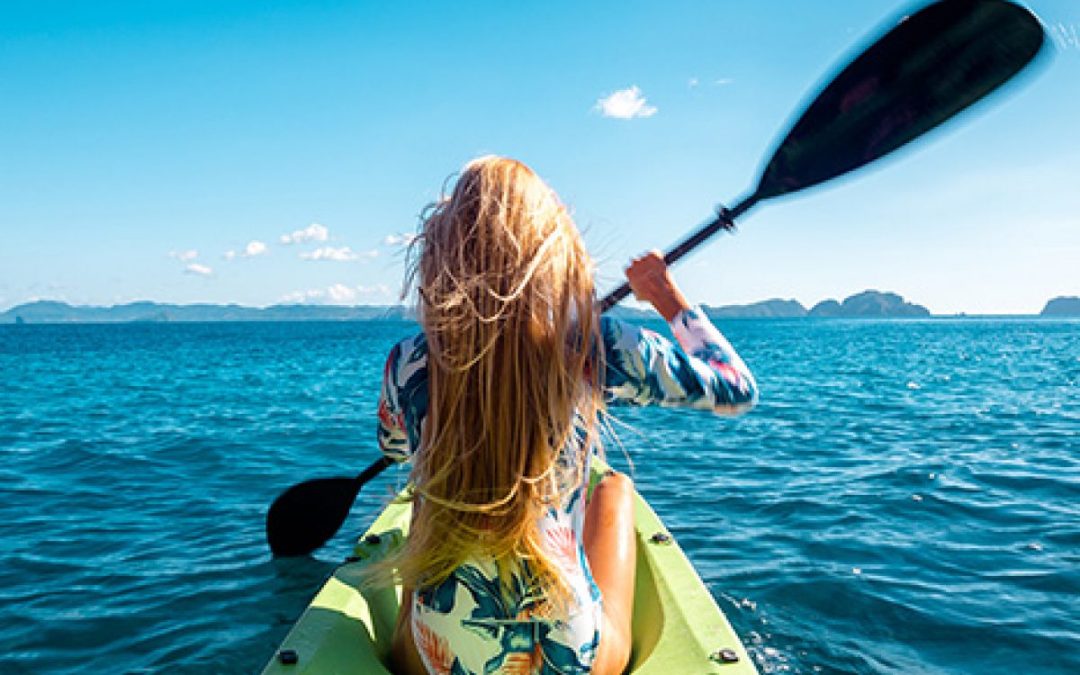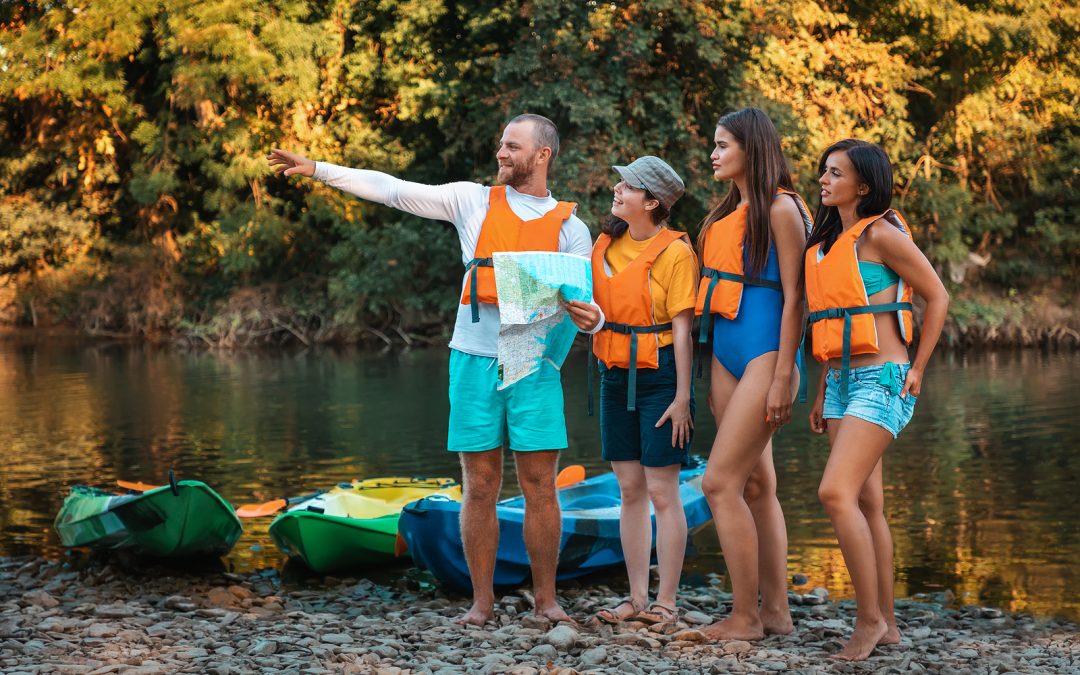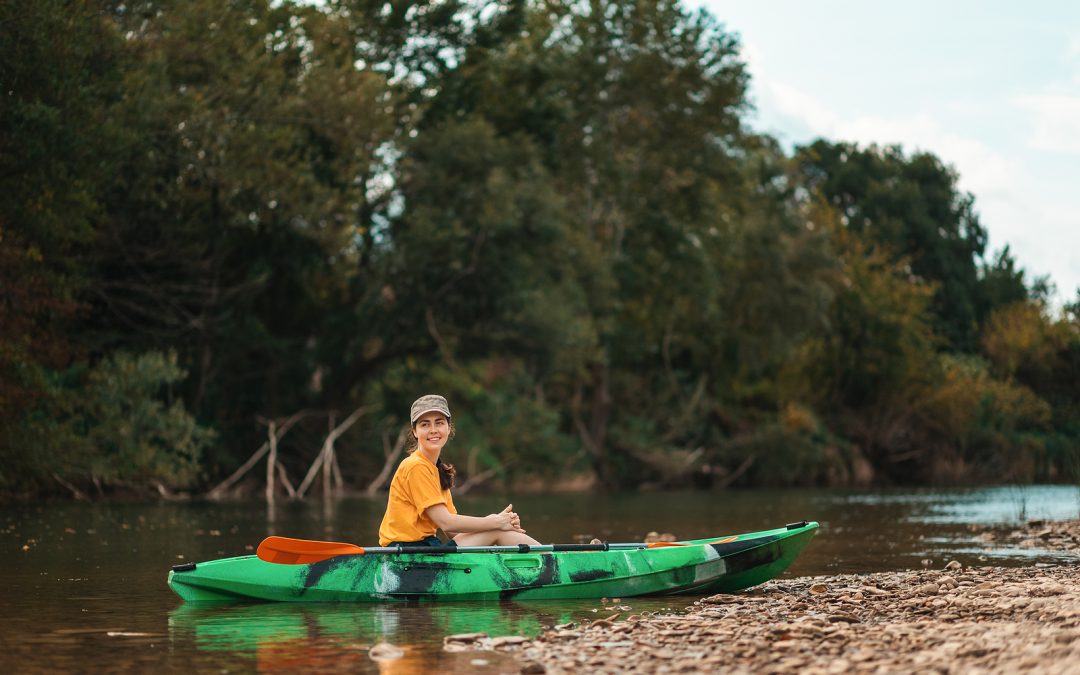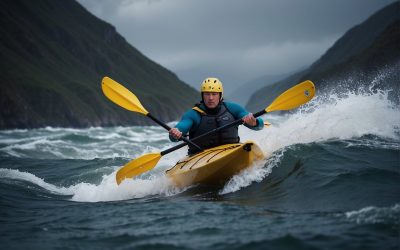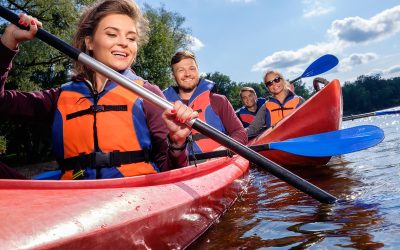How to Paddle a Kayak: Expert Techniques Simplified
Paddling a kayak is an enjoyable recreational activity that promotes physical fitness, mental well-being, and allows us to experience nature from a unique vantage point. Whether you are a seasoned paddler or a beginner eager to learn, understanding the fundamentals of paddling is essential to staying safe and getting the most out of your time on the water. In this article, we will cover the essential aspects that will help you paddle confidently, including choosing the right paddle and mastering the basic paddling techniques.
To begin your journey into the world of kayaking, it is crucial to familiarize yourself with the basics of a kayak paddle and how to choose the one best suited for your needs. Paddle selection will depend on factors like size, materials, and blade style. Once you have your paddle, learning and maintaining proper grip and posture are necessary for efficient paddling and injury prevention. With the right mindset and equipment, you are now ready to immerse yourself in the diverse paddling techniques that cater to different water conditions and environments.
Key Takeaways
- Learn the fundamentals of paddling for a safe and enjoyable experience
- Familiarize yourself with kayak paddles and master proper grip and posture
- Diversify your skills with various paddling techniques and handling different water conditions
Understanding the Basics of a Kayak Paddle
A kayak paddle is an essential tool for navigating through the water while kayaking. Before learning how to paddle effectively, it is important to understand the basic anatomy and characteristics of a kayak paddle. This section will provide a clear and concise overview of the elements that make up a typical paddle.
The primary components of a kayak paddle are the shaft and the blades. The shaft is the long, central part of the paddle that the user grips, while the blades are the flat, wide portions at each end of the shaft used to push against the water. Most kayak paddles have two blades, but there are also single-blade paddles available for specialized kayaking activities.
Paddle blades come in two main types: symmetrical and asymmetrical. Symmetrical blades are identical on both sides and are generally used for recreational or beginner kayaking, as they provide equal power on each stroke. Asymmetrical blades, on the other hand, have one side larger than the other and are typically used for performance or touring kayaks. These blades are designed to reduce wind resistance and displace more water for more efficient paddling.
Another factor to consider is the length of the paddle. The right size depends on the paddler’s height, the width of the kayak, and the specific paddling style. Generally, taller paddlers and wider kayaks require longer paddles.
The material of the kayak paddle plays a significant role in its weight, durability, and performance. Common materials used in the construction of paddles include plastic, fiberglass, and aluminum. Each material has its advantages and drawbacks:
- Plastic: Lightweight but less durable, plastic paddles are suitable for beginners or recreational kayakers who prioritize affordability.
- Fiberglass: A good balance between weight and durability, fiberglass is suitable for intermediate or more experienced kayakers. These paddles are also available in various colors, making them more visually appealing.
- Aluminum: Robust and durable, aluminum paddles are heavier than their plastic and fiberglass counterparts. They can withstand harsh conditions and are suitable for rough water or more rigorous kayaking activities.
When selecting a kayak paddle, consider the variety of sizes and material options available to find the paddle that best suits your needs and level of experience. A well-chosen paddle will make paddling more enjoyable and efficient, allowing you to better enjoy your time on the water.
Choosing the Right Paddle
Paddling a kayak requires selecting the appropriate paddle to ensure efficiency, comfort, and success. Several factors need to be considered when choosing the right paddle, such as length, weight, shaft type, and blade design.
Length plays a significant role in paddling efficiency. To find the right length, consider the size of the kayak and the paddler’s height. A wider kayak requires a longer paddle, while a shorter paddle suits a narrow or low kayak well. The paddler’s height affects the paddle length as well; taller individuals typically need longer paddles, while shorter individuals find shorter paddles more comfortable.
Weight is another essential factor. A lighter paddle will reduce fatigue on long paddling excursions, while a heavier paddle can provide more stability. Balance the weight and comfort according to personal preference and paddling style.
The shaft is the central part of the paddle, connecting the blades. There are two primary types: straight shaft kayak paddle and bent shaft kayak paddle. Straight shaft paddles are more common, affordable, and provide greater control. Bent shaft paddles are designed to relieve stress on the wrists and ensure a more comfortable grip.
Symmetrical blades have both sides of the blade shaped the same, which can be more maneuverable. Asymmetrical blades have one side longer and flatter than the other, providing power on one side and allowing for a smoother entry into the water.
Flat blades are ideal for beginners, as they provide an even distribution of power throughout the stroke. Feathered blades have one blade at a different angle than the other, reducing wind resistance.
Considering price is essential, but so is selecting a durable and comfortable paddle. Some affordable and reliable paddle options include the Werner Skagit FG, Bending Branches Whisper, and Carlisle Magic Plus.
In conclusion, the perfect paddle should match the kayak’s size and the paddler’s height. It should also be comfortable, efficient, and within budget. Careful assessment of factors such as length, weight, shaft type, and blade design will lead to a more enjoyable experience on the water.
Getting into the Kayak
Before getting into the kayak, ensure all necessary gear is worn, including the personal flotation device (PFD). Choose a stable and calm spot to enter the boat and have someone nearby to assist if needed. Place the kayak parallel to the shore, with the bow facing the desired direction.
Keep one hand on the cockpit’s edge for support as you step into the kayak, placing the foot nearest the boat in the center of the cockpit. Maintaining a firm hold, lower the body weight into the boat while bending the knees. Slide both feet into the cockpit simultaneously, positioning them on the footrests.
Once seated, adjust the backrest to provide ample back support and promote good posture. Sit comfortably, slightly leaning back, with the buttocks nestled at the back of the seat. Shoulders should be relaxed, and spine straight. Firmly place the thighs and knees under the thigh braces for additional support and control.
Ensure a balanced sitting position within the kayak by evenly distributing body weight. This stable position enhances paddling efficiency and lowers the chances of capsizing.
After adjusting the backrest and achieving proper posture, ensure all equipment, including the paddle, is readily accessible. Now, the kayaker is ready to embark on their paddling adventure with full confidence.
Proper Grip and Posture
When it comes to kayaking, maintaining proper grip and posture is essential for efficiently navigating through the water. A strong foundation in these areas not only improves paddling performance, but also ensures a comfortable and enjoyable experience.
To achieve a proper grip, one should hold the paddle with both hands shoulder-width apart, ensuring that the knuckles are aligned with the edge of the paddle blades. The grip should be firm yet comfortable, allowing for smooth and efficient movement without causing strain on the wrists.
Good posture is crucial for both comfort and effective paddling. Maintaining a straight back with relaxed shoulders will provide a solid base for applying force through the paddle. It is also important to engage the core muscles, as this will aid in the transfer of power and help to protect the lower back from strain.
When paddling, one should focus on keeping their shoulders and wrists relaxed to minimize fatigue and prevent injury. Efficient paddling involves using the whole body, rather than solely relying on arm strength. By incorporating both the arms and torso, a kayaker can maintain a more natural and fluid motion, which in turn conserves energy and increases overall performance.
In summary, proper grip and posture play a vital role in a successful and enjoyable kayaking experience. By consistently practicing these techniques, a kayaker can improve their skills, reduce the risk of injury, and ensure a comfortable time out on the water.
Basic Paddling Techniques
Paddling a kayak requires mastering a few key techniques. By learning and practicing these techniques, kayakers can efficiently and smoothly navigate on water, making their experience more enjoyable.
The forward stroke is the most fundamental paddling technique. To perform a forward stroke, the paddler should sit up straight, hold the paddle with a firm grip, and engage their core muscles. They should submerge one of the paddle blades into the water near their toes while twisting their torso. The paddler should then pull the submerged blade back alongside the kayak, exit the water near their hips, and repeat on the opposite side.
The sweep stroke is essential for turning the kayak. To execute a sweep stroke, the paddler should rotate their torso while extending the paddle blade as far as possible, forming a wide arc in the water. They should then push the paddle in a sweeping motion towards the stern (rear) of the kayak, effectively turning the kayak in the opposite direction of the paddle.
The reverse stroke is useful for slowing down or moving backwards. The paddler should begin by placing the paddle blade behind their hips, then move it towards the bow (front) of the kayak in a straight line while keeping their arms straight and torso twisted.
The draw stroke is great for moving the kayak sideways. To perform a draw stroke, the paddler should reach out with the paddle, submerge the blade in the water near their hips, and draw the paddle towards the kayak, pulling the kayak towards the paddle. The blade should be removed from the water before it reaches the kayak and then repositioned for another stroke.
Proper kayak paddling technique incorporates feathering the paddle blades. Feathering refers to the rotation of the paddle shaft, allowing the blades to enter and exit the water at a more efficient angle. Paddlers may opt to use a feathered paddle, to reduce air resistance and increase leverage.
By understanding and applying these basic paddling techniques, kayakers can efficiently navigate, turn, and maintain control of their kayak, ensuring a safe and enjoyable experience on the water.
How to Handle Different Water Conditions
When it comes to kayaking, water conditions can greatly impact your ability to paddle effectively. In this section, we will discuss how to handle various water conditions, including wind, waves, and currents. By mastering these techniques, you can confidently navigate your kayak in any situation.
In windy conditions, it’s essential to adjust your stroke to maintain control of your kayak. When paddling into a headwind, use a shorter, more forceful stroke to push through the resistance. If you’re dealing with a crosswind, try leaning slightly into the wind, angling your paddle to compensate for the wind’s push. Utilizing a skeg or a rudder can also help you maintain your desired course in windy situations.
While paddling in waves or choppy water, maintaining balance and control is crucial. Practicing a low brace position, with your paddle on the side of the kayak, will help improve stability. As you encounter waves, lean towards them and use your hips to absorb the impact, keeping your upper body stable. Additionally, in a sea kayak, it’s helpful to learn edging techniques to tilt the kayak on its side slightly, allowing the natural shape of the hull to assist in maneuvering through waves.
Currents can also present challenges when kayak paddling. To prevent being pushed off course, modify your paddling technique to counteract the current’s effects. When paddling upstream, use a powerful, shorter stroke, while paddling downstream may require longer, sweeping strokes to maintain control. If needing to cross a current, angle your kayak slightly upstream and use forward strokes to move across the current efficiently.
In varying water conditions, it’s essential to adjust your kayak paddling technique to maintain control and confidence on the water. By practicing these methods, you will be better prepared to tackle any situation that may arise while enjoying your time in your kayak.
Advanced Paddling Techniques
One advanced paddling technique is the high brace, which prevents a kayak from capsizing. To execute this technique, the paddler maintains a wide grip on the paddle with bent elbows, ensuring a strong and stable position. A firm twist of the torso engages the core muscles, making the high brace effective against powerful waves and rapids.
Feathering the paddle helps reduce wind resistance, preserving energy and increasing paddling efficiency. It redirects the paddle’s angle relative to the wind at the top of each stroke. To perform feathering, one hand rotates the paddle shaft, while the other remains stationary. For novice kayakers, this technique might require guidance from an experienced instructor, as it takes time for the feathering motion to become ingrained in muscle memory.
In addition to feathering, proper body rotation plays a critical role in advanced paddling techniques. This involves rotating the torso instead of relying solely on arm strength. Proper body rotation not only increases performance but also aids in injury prevention. It redistributes the work among larger and more powerful muscle groups, reducing stress on the shoulders and wrists.
The bow draw and stern draw are essential for controlling the kayak’s direction. These techniques involve angling the paddle blade to “draw” water towards the bow or stern of the kayak, which causes a turn. Professionals recommend using a combination of these techniques to maneuver through tight spaces and navigate challenging water conditions.
In conclusion, advanced paddling techniques demand proper execution and persistence to master. By practicing these skills and working with a knowledgeable instructor, paddlers can improve their performance, safety, and enjoyment on the water.
Taking Care of Your Kayak Paddle
Proper care and maintenance of your kayak paddle are essential to ensure it remains durable and efficient during your paddling adventures. By considering the main components of a paddle, such as the shaft, blades, and material, you can extend the life of your equipment and optimize its performance.
The first step in maintaining your kayak paddle is to regularly inspect the shaft and blades for any signs of wear, damage, or corrosion. It is advisable to clean the shaft with a soft cloth and mild soap after each use, especially if it comes into contact with saltwater. Be mindful of the paddle’s length, as longer paddles will require more attention due to increased areas of contact with the water or the kayak.
Choose a high-quality storage solution to protect your paddle from extreme temperatures and UV exposure when not in use. Store the paddle in a dry, well-ventilated area to prevent the buildup of moisture and mold. Moreover, it’s essential to disassemble the paddle if it has a two-piece design, ensuring that its parts dry properly.
The kayak paddle’s material is a significant factor that can impact its durability and performance. Common materials like aluminum, fiberglass, or carbon fiber have their unique characteristics. Aluminum shafts are affordable and robust, but they might be susceptible to corrosion if subjected to saltwater. Fiberglass shafts offer lightweight and durable properties, while carbon fiber shafts provide the benefits of being both lightweight and robust. Always choose a paddle that best suits your needs and the type of kayaking you plan to do.
Lastly, invest in a paddle leash, which can prevent paddle loss and protect it from potential damage in turbulent waters. A leash can also provide an added layer of safety, ensuring the paddle remains close in case of an unexpected capsize.
By following these essential guidelines, you can ensure that your kayak paddle remains in optimal condition and continue to enjoy your kayaking adventures for years to come.
Paddling is a fun and exciting way to explore the water. To get started, first, find a comfortable and sturdy kayak or canoe that suits your needs. Next, adjust your paddle to the correct length and grip it firmly with both hands. When paddling, keep your arms straight and use your core muscles to rotate your torso and propel the paddle through the water. Remember to maintain a steady rhythm and use your paddle to steer in the direction you want to go. With practice, you’ll become a skilled paddler and be able to navigate any body of water with ease.


Conclusion
Paddling a kayak efficiently and comfortably depends on mastering the right technique. When an individual develops proper kayaking skills, they will find the experience more enjoyable. As they embark on their kayaking journey, it is essential to remember the key components of a successful paddling adventure.
Firstly, selecting an appropriate paddle is crucial. The optimal length and material can significantly influence a kayaker’s comfort and performance while paddling. In addition, an individual should practice proper grip and posture as they maneuver their kayak. Good posture and a relaxed grip lay the foundation for strong, efficient strokes.
When it comes to paddling technique, kayakers should focus on the three main strokes: forward, reverse, and sweep strokes. Each stroke serves a unique purpose for moving, stopping, or turning the kayak. Continual practice and refining of these techniques will lead to a smooth, efficient paddling style.
Finally, always consider safety precautions while kayaking. Wearing a personal flotation device, checking the weather, and understanding the water conditions can greatly contribute to a secure and enjoyable kayaking experience.
By incorporating these elements, a kayaker can ensure a comfortable and successful time on the water.





